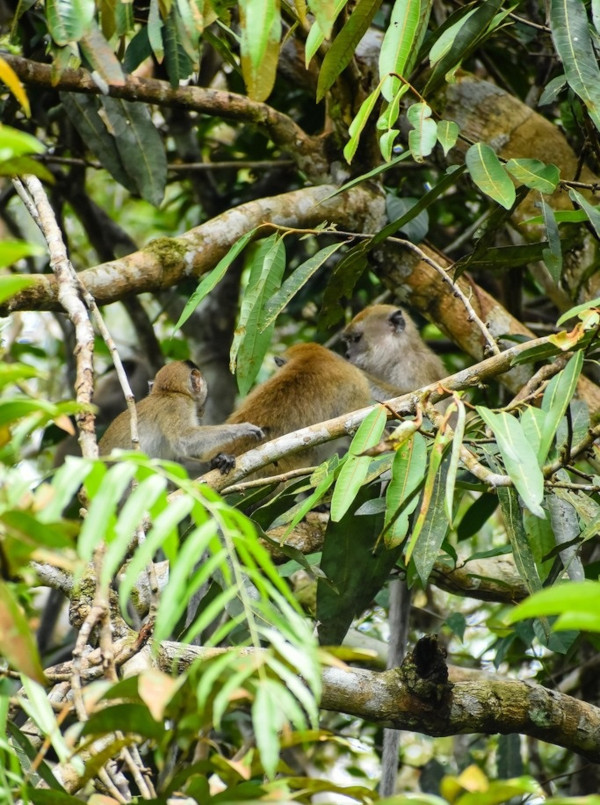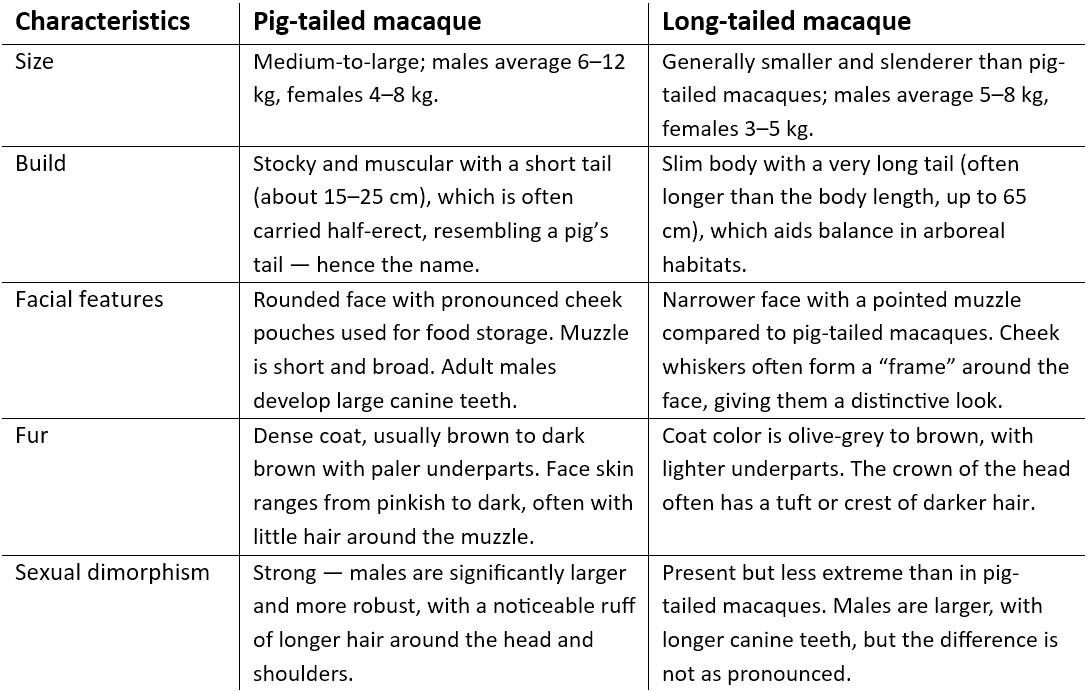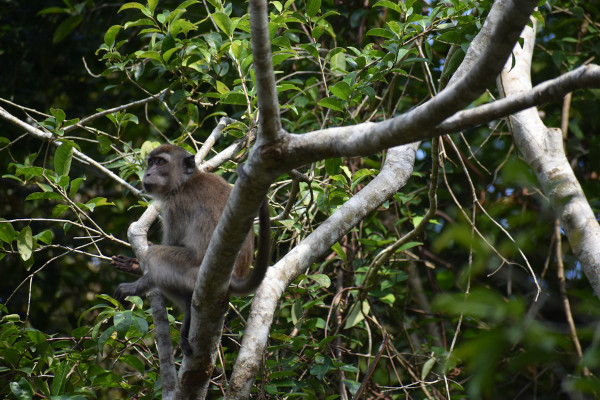November 14, 2025
Covering an area of 150,693 hectares on the Kampar Peninsula and Padang Island in Sumatra, the Restorasi Ekosistem Riau (RER) project area supports a staggering array of biodiversity. Our latest survey, completed in June 2025, documented a total of 901 distinct species, including 78 mammals, 106 amphibian and reptiles, 319 birds, 207 plants, 89 fish, and 102 odonates.
Among these are two primate species: the pig‑tailed (Macaca nemestrina) and the long‑tailed (Macaca fascicularis) macaques. But how do we identify and differentiate between these two commonly confused macaque species? What role do each of them play in their ecosystem? And how are we working to support their conservation at RER?
In this article, we’ll walk you through five differences between pig-tailed and long-tailed macaques, and reveal how RER safeguards both species. Let’s get started.
1. Taxonomy Differences
The pig-tailed macaque (Macaca nemestrina) and the long-tailed macaque (Macaca fascicularis) are both members of the genus Macaca within the family Cercopithecidae (Old World monkeys). Here’s a little more detail about the differences in their taxonomy:
Understanding these taxonomic details helps researchers identify each species correctly during RER’s biodiversity monitoring activities. But the first method they use to tell them apart is their physical characteristics.

2. Physical Characteristics
As the name suggests, the pig‑tailed macaque has a short tail that curves upward (like a pig’s tail), while the long‑tailed macaque has a significantly longer tail. Another key difference is their body size: Pig‑tailed macaques weigh between 5–15 kg and have buff-brown coats with darker backs, whereas long‑tailed macaques are typically smaller and slenderer. Recognizing these features makes field identification and monitoring much more reliable.


3. Habitat and Range in RER
Recent camera trap data confirm both species are present on the Kampar Peninsula and Padang Island.
4. Behavior and Diet
Long‑tailed macaques are highly adaptable and have a broad diet, which includes crabs and other aquatic life (hence the nickname “crab-eating macaque”). They sometimes scavenge near human settlements. As a result, they are often described as ‘gangs’ or ‘thieves,’ especially in urban areas; this is both a reflection of their bold behavior, and of the human tendency to anthropomorphize (and occasionally demonize) certain species.
Pig‑tailed macaques, by comparison, do not have access to or regularly eat aquatic/coastal food like crabs, though they are skilled climbers and enjoy water. They typically live in large groups, splitting up during feeding, and communicate by puckering their lips. Their diet includes fruit, seeds, fungi, and invertebrates.
5. Ecological Role and Conservation Status
Both species play important ecosystem roles as seed dispersers. Their presence in RER reflects the health of the landscape. However, both feature on the IUCN Red List, due to a combination of hunting, exploitation, and habitat loss through deforestation.
Both pig‑tailed macaques and long‑tailed macaques are classified as Endangered (EN) on the IUCN Red List, with Habitat loss and hunting being major threats to their survival in the wild. Long-tailed macaques are among the most heavily traded primates globally; many are captured for the pet trade, traditional medicine, and especially for use in biomedical research laboratories.

RER’s Efforts to Protect Macaques
RER actively monitors both species using camera traps and surveys across the Kampar Peninsula. The results are promising – data reveals that, in spite of the challenges they face elsewhere, long-tailed macaques are flourishing on Padang Island (RER Progress Report 2024, p18) and are in fact “the most abundant species on the island.”
RER protects habitat through patrols, old canal closures, and community engagement to reduce threats like hunting, logging, and fire – all of which benefit both macaque species. Key to this approach is research and collaboration; thanks to partnerships and collaborations established with several wildlife protection organizations.
Monitoring species like the pig- and long-tailed macaques is essential to their conservation. As Yoan Dinata, Biodiversity Conservation Manager at RER, confirms: “Accurately distinguishing these macaques helps us tailor protection strategies and understand how restoration impacts each species differently.”
You can learn more about these efforts, and our recent progress, in the 2024 Progress Report.
FAQs: RER and Biodiversity Protection
Q: Why does RER monitor pig‑tailed macaques and long‑tailed macaques separately?
A: Each species responds differently to habitat change. Unique data helps inform better conservation actions.
Q: How is RER improving habitat conditions for pig‑tailed macaques and long‑tailed macaques?
A: By restoring peat hydrology, planting native trees, reducing fires, and working with local communities to promote sustainable livelihoods.
Q: Where can I learn more?
Visit RER’s website and read the latest Progress Report for full details, including camera trap data, species lists, and restoration milestones.
Related links and further reading:
Stay up to date with the latest news and events updates from RER